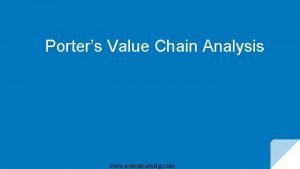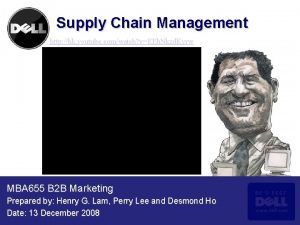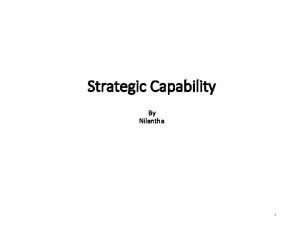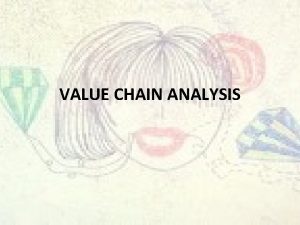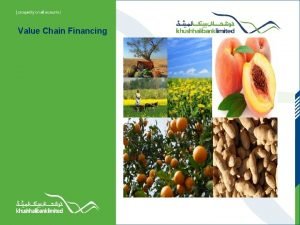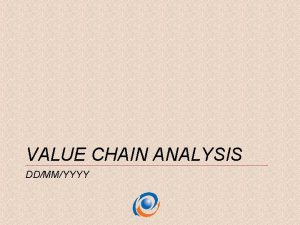Value chain analysis activity Value chain analysis Conceptual







- Slides: 7

Value chain analysis activity

Value chain analysis • Conceptual framework for looking at the relationships among the actors and activities involved in creating good and services in a global economy • “The full range of activities, including coordination, that are required to bring a specific product from its conception to its end use and beyond” (Gereffi & Christian, 2009, p. 358)

Value chain analysis: Key elements 1. Input‐output structure: Entire process that brings a good from conception to the consumer (R&D, production, distribution, marketing/sales). Includes the main activities/segments in the value chain. For example: Source: Gereffi & Fernandez-Stark, 2016.

Value chain analysis: Key elements 2. Geography: Where is the input-output structured carried out? For example, tomatoes grown and processed in California and retailed across the U. S. and Canada. 3. Governance: Who controls the activities in the chain? There could be very few or several key actors/firms that control different parts of the value chain. For example, a branded manufacturer like Heinz may control most activities in the processed tomato value chain (from the seeds that are grown through to distribution to supermarkets). If we take the example of coffee, a coffee co-operative may control production, an exporter company may control shipping, and a roaster may control distribution to retailers/cafes.

Activity #7: Instructions (slide 1 of 2) Using your selected food or food product, answer the following questions below. This should take the form of a written submission that is approximately 400 -500 words. You are welcome to use visuals to answer questions #1 and #2. #1. What is the input-output structure of your selected food/food product? #2. Geography: Where are the input-output activities based? #3. Who controls different activities along the chain? Note: If accessible information to answer this question is lacking, please say so in your response and indicate what specific questions related to governance you would like to learn more about, particularly in the context of your answers to questions #1 and #2. Further instructions: - Please cite at least one secondary source (properly referenced) to complete the questions above. For example, this could be a company website or a report about your selected food commodity. - Please submit as a Word Document by the due date via Moodle.

Activity #7: Instructions (slide 2 of 2) A value chain ‘quiz’ has been posted on Moodle (under the November 16 th class material). It contains a set of short questions based on this activity. You have until the end of day on November 16 th to complete this short ‘quiz’ as part of your class participation grade.

References Gereffi, G. , Lee, J. , & Christian, M. (2009). US-Based Food and Agricultural Value Chains and Their Relevance to Healthy Diets. Journal of Hunger & Environmental Nutrition, 4(3 -4), 357– 374. http: //doi. org/10. 1080/19320240903321276 Gereffi, G. & Fernandez-Stark, K. (2016). Global value chain analysis: A primer. Retrieved online https: //gvcc. duke. edu/wpcontent/uploads/Duke_CGGC_Global_Value_Chain_GVC_Analysis_Primer_2 nd_ Ed_2016. pdf



